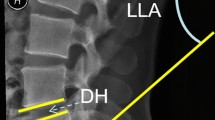Abstract
Degenerative disease of the lumbar spine is common in ageing populations. It causes disturbing back pain, radicular symptoms and lowers the quality of life. We will focus our discussion on the surgical options of posterior lumbar interbody fusion (PLIF) and transforaminal lumbar interbody fusion (TLIF) and minimally invasive transforaminal lumbar interbody fusion (MI-TLIF) for lumbar degenerative spinal deformities, which include symptomatic spondylolisthesis and degenerative scoliosis. Through a description of each procedure, we hope to illustrate the potential benefits of TLIF over PLIF. In a retrospective study of 53 ALIF/PLIF patients and 111 TLIF patients we found reduced risk of vessel and nerve injury in TLIF patients due to less exposure of these structures, shortened operative time and reduced intra-operative bleeding. These advantages could be translated to shortened hospital stay, faster recovery period and earlier return to work. The disadvantages of TLIF such as incomplete intervertebral disc and vertebral end-plate removal and potential occult injury to exiting nerve root when under experienced hands are rare. Hence TLIF remains the mainstay of treatment in degenerative deformities of the lumbar spine. However, TLIF being a unilateral transforaminal approach, is unable to decompress the opposite nerve root. This may require contralateral laminotomy, which is a fairly simple procedure. The use of minimally invasive transforaminal lumbar interbody fusion (MI-TLIF) to treat degenerative lumbar spinal deformity is still in its early stages. Although the initial results appear promising, it remains a difficult operative procedure to master with a steep learning curve. In a recent study comparing 29 MI-TLIF patients and 29 open TLIF, MI-TLIF was associated with longer operative time, less blood loss, shorter hospital stay, with no difference in SF-36 scores at six months and two years. Whether it can replace traditional TLIF as the surgery of choice for degenerative lumbar deformity remains unknown and more studies are required to validate the safety and efficiency.
Similar content being viewed by others
References
Middleton K, Fish DE. Lumbar spondylosis: Clinical presentation and treatment approaches. Curr Rev Musculoskeletal Med 2009;2:94–104.
Roh JS, Teng AL, Yoo JU, Davis J, Furey C, Bohlman HH. Degenerative disorders of the lumbar and cervical spine. Orthop Clin North Am 2005;36:255–62.
Mummaneni PV, Haid RW, Rodts GE. Lumbar interbody fusion: State-of-the-art technical advances. J Neurosurg Spine 2004;1:24–30.
Lin PM. Posterior lumbar interbody fusion technique: Complications and pitfalls. Clin Orthop Relat Res 1985;193:90–102.
Briggs H, Milligan P. Chip fusion of the low back following exploration of the spinal canal. J Bone Joint Surg Am 1944;26: 125–30.
Cloward RB. The treatment of ruptured lumbar intervertebral discs by vertebral body fusion: I: Indications, operative technique, after care. J Neurosurg 1953;10:154–68.
Ray CD. Threaded titanium cages for lumbar interbody fusions. Spine 1997;22:667–79.
Branch CL, Branch CL Jr. Posterior lumbar interbody fusion with the keystone graft: Technique and results. Surg Neurol 1987;27:449–54.
Simmons JW. Posterior lumbar interbody fusion with posterior elements as chip grafts. Clin Orthop Relat Res 1985;193:85–9.
Harms J, Rolinger H. A one-stager procedure in operative treatment of spondylolisthesis: Dorsal traction-reposition and anterior fusion. Z Orthop Ihre Grenzgeb 1982;120:343–7.
Branch CL Jr. The case for posterior lumbar interbody fusion. Clin Neurosurg 1996;43:252–67.
Steffee AD, Sitkowski DJ. Posterior lumbar interbody fusion and plates. Clin Orthop Relat Res 1988;227:99–102.
Brodke DS, Dick JC, Kunz DN, McCabe R, Zdeblick TA. Posterior lumbar interbody fusion: A biomechanical comparison, including a new threaded cage. Spine 1997;22:26–31.
Hee HT, Castro FP Jr, Majd ME, Holt RT, Myers L. Anterior/ posterior lumbar fusion versus transforaminal lumbar interbody fusion: Analysis of complications and predictive factors. J Spinal Disord 2001;14:533–40.
Hackenberg L, Halm H, Bullmann V, Vieth V, Schneider M, Liljenqvist U. Transforaminal lumbar interbody fusion: A safe technique with satisfactory three to five year results. Eur Spine J 2005;14:551–8.
Holly LT, Schwender JD, Rouben DP, Foley KT. Minimally invasive transforaminal lumbar interbody fusion: Indications, technique, and complications. Neurosurg Focus 2006;20:E6.
Shen FH, Samartzis D, Khanna AJ, Anderson DG. Minimally invasive techniques for lumbar interbody fusions. Orthop Clin North Am 2007;38:373–86.
Park P, Foley KT. Minimally invasive transforaminal lumbar interbody fusion with reduction of spondylolisthesis: Technique and outcomes after a minimum of 2 years’ follow up. Neurosurg Focus 2008;25:E16.
Deutsch H, Musacchio MJ Jr. Minimally invasive transforaminal lumbar interbody fusion with unilateral pedicle screw fixation. Neurosurg Focus 2006;20:E10.
Dhal SS, Wang MY, Mummaneni PV. Clinical and radiographic comparison of mini-open transforaminal lumbar interbody fusion with open transforaminal lumbar interbody fusion in 42 patients with long-term follow-up. J Neurosurg Spine 2008;9:560–5.
Peng CW, Yue WM, Tan SB. Clinical outcome of minimally invasive versus open transforaminal lumbar interbody fusion. Spine J 2007;5:61S.
Schizas C, Tzinieris N, Tsiridis E, Kosmopoulos V. Minimally invasive versus open transforaminal lumbar interbody fusion: Evaluating initial experience. Int Orthop 2009;33:1683–8.
Author information
Authors and Affiliations
Corresponding author
Rights and permissions
About this article
Cite this article
Hey, H.W.D., Hee, H.T. Lumbar degenerative spinal deformity: Surgical options of PLIF, TLIF and MI-TLIF. IJOO 44, 159–162 (2010). https://doi.org/10.4103/0019-5413.62066
Published:
Issue Date:
DOI: https://doi.org/10.4103/0019-5413.62066




